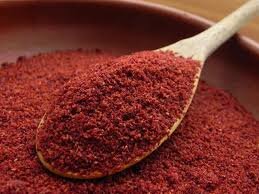Each month we showcase a different spice. Its over to you to come up with your tips, tricks or recipes using the spice. There is a prize for the most interesting idea or recipe (to be posted anywhere in the world, customs permitting). Just add your ideas to this thread or if you have a recipe, then post it as a new thread and tag it ’sumac' and 'spice challenge'. So, as you already realised, this month, the featured spice is Sumac! Deadline for entries midday 5th March Feb. 2018 (GMT).

Sumac - the Info:
Cultivation
Sumac comes from the berries of a wild bush that grows wild in all Mediterranean areas, especially in Sicily and southern Italy, and parts of the Middle East, notably Iran. The berries are dried and crushed to form a coarse purple-red powder. The whole fruit appears in dense clusters. Individual berries are small, round and russet coloured.
Aroma and flavour
Sumac has a citrus lemony tang. The berries have little aroma, but a definite astringent quality with a delicious sour flavour.
Culinary use
Sumac is widely used in Lebanese, Syrian, Turkish and Iranian cuisines. The berries can be used whole or ground. The berries can also be soaked in warm water for 15 to 20 mins and squeezed to produce there astringent juice which can be added to dishes. Ground sumac can be used as a rub for fish or meat, sprinkled over salads or added to vegetables before roasting. Sumac is one of the main components in the spice mix Zaa'atar and is used as a topping on Fatoush salad, and makes a great topping on dips like hummus.
So its over to you. How do you use sumac? Tell us your ideas, tips and recipes for using this spice. And if you have never tried this exotic spice, then now is your opportunity! Deadline for entries is midday 5th March 2018 (GMT).

Sumac - the Info:
Cultivation
Sumac comes from the berries of a wild bush that grows wild in all Mediterranean areas, especially in Sicily and southern Italy, and parts of the Middle East, notably Iran. The berries are dried and crushed to form a coarse purple-red powder. The whole fruit appears in dense clusters. Individual berries are small, round and russet coloured.
Aroma and flavour
Sumac has a citrus lemony tang. The berries have little aroma, but a definite astringent quality with a delicious sour flavour.
Culinary use
Sumac is widely used in Lebanese, Syrian, Turkish and Iranian cuisines. The berries can be used whole or ground. The berries can also be soaked in warm water for 15 to 20 mins and squeezed to produce there astringent juice which can be added to dishes. Ground sumac can be used as a rub for fish or meat, sprinkled over salads or added to vegetables before roasting. Sumac is one of the main components in the spice mix Zaa'atar and is used as a topping on Fatoush salad, and makes a great topping on dips like hummus.
So its over to you. How do you use sumac? Tell us your ideas, tips and recipes for using this spice. And if you have never tried this exotic spice, then now is your opportunity! Deadline for entries is midday 5th March 2018 (GMT).


